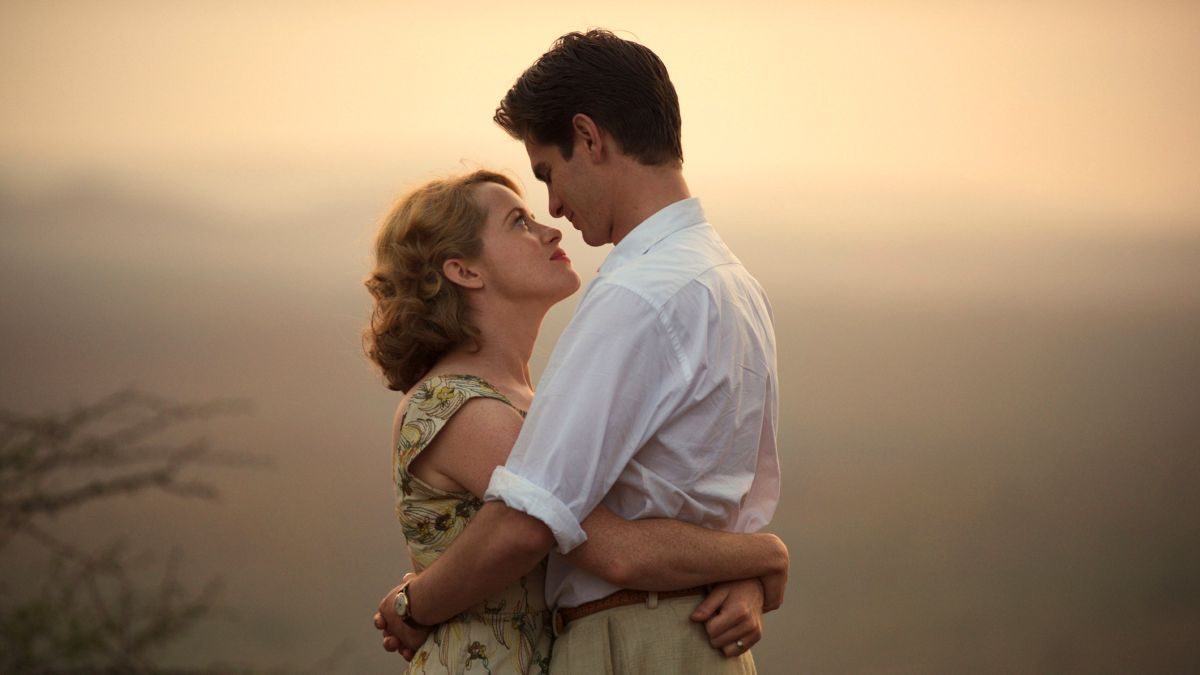 (2 / 5)
(2 / 5)
Breathe is a film about which it’s easy to be cynical.
The directorial debut of Andy Serkis1, the film was commissioned by Serkis’ Imaginarium Studios2 co-founder John Cavendish as a tribute to his father, disability advocate Robin.3 As such, it seems designed to squeeze every breath of uplift you from Robin’s already inspirational story.4
Robin Cavendish (Andrew Garfield)5 is a charming, athletic young fellow, who enjoys a game of cricket, girls in floral dresses, and is self-employed as a tea-broker in Africa.6 While on a trip there with his wife Diana (Claire Foy displaying the same indomitability as in The Crown)7, he is stricken, cruelly and suddenly, with polio. Paralysed and bed-bound, reliant on a ventilator to breathe, the doctors back in England are quick to write him off.8 However, through sheer pluck and perseverance9, Robin and Diana are able to secure him a new lease on life.
Breathe‘s script, commissioned from the Oscar-nominated William Nicholson, takes the form of a life-affirming series of lightly-sketched incidents; such as a trip to Spain on which Robin’s automatic ventilator breaks down, leaving them all stranded.10 Only two such scenes indicate what the film might have been with a little more depth to it. In the first, Robin’s ventilator is accidentally unplugged while he’s alone in the downstairs living room which serves as his bedroom.11 Garfield’s eyes water, his breath catching terrifyingly in his throat – ch ch ch – as realisation dawns. In a role that otherwise relatively little in the way of physical acting challenges12, this moment helps to convey the horror and helplessness of a man who is facing death because he is unable to attract the attention of his wife in the neighbouring room.
In the second, Robin and his friends – including an enthused Stephen Mangan and Tom Hollander as Diana’s plummily eccentric twin brothers13 – take a trip to a state-of-the-art facility in Germany, only to discover a 2001-style white room where patient’s heads project from iron lungs built into the walls and the staff are oblivious to the dehumanising effect. This, and the speech Robin gives shortly after, suggests a film that might well have taken a serious look about how society treats disabled people beyond their immediate survival; not hiding them away in wards, confined to beds, but enabling them to live full and fulfilling lives.14
With Nitin Sawhney’s soaring, jazzy score15 and Robert Richardson’s airy cinematography, Breathe is, despite its performances and the proficient film-making on display, the safest version of this story. The film is a lump of rough crystal, or diamanté. You can hold it up to the light, look for hidden depths, but ultimately there’s nothing to it beyond the surface gleam. It’s a nice gleam, though.
- Not counting Warner Bros. as-yet unreleased Jungle Book adaptation
- Who provided digital effects for the new Planet of the Apes series – including War For… – in which Serkis also stars.
- Serkis also starred in Sex & Drugs & Rock & Roll as punk rock n’ roller Ian Dury, who was himself a polio survivor.
- The film’s opening – an aerial view of the English countryside, rolling yellow fields and verdant woodland, gloriously shot in silver ratio – with the title in curly, bold, yellow font seem like a mission statement in this regard.
- Who, between this, Hacksaw Ridge, Silence, and Angels in America – which I was lucky enough to see onstage at the National Theatre – Garfield has developed a certain line in noble suffering.
- The poster unfortunately suggests a remake of last year’s LFF opener A United Kingdom from the romanticised perspective of the colonialists.
- Making her an unexpected but logical pick for the new Lisbeth Salander in the upcoming Girl in the Spider’s Web adaptation
- As shown in the figure of Jonathan Hyde’s forbidding, vindictive head doctor, the film as a whole has a dim view of the medical profession.
- And, well, money and the help of some mechanically gifted friends, including ruddy-faced inventor Teddy Hall (Hugh Bonneville).
- But don’t worry, the locals throw a party in the lay-by, complete with lights, and the whole thing ends with them applauding.
- The house itself, purchased for a song, is a large redbrick manse with ivy and bricked-up windows – perfect for bohemian gatherings, birthdays, and Christmas parties.
- Unlike in, say, Theory of Everything, the onset of the disease is immediate; leaving little opportunity to document the decline.
- At least whenever the film can afford to have them both. Though it does give us Tom Hollander harmonising with himself on “Good-bye-ee!”, dressed in striped blazer(s) and straw boater(s).
- And, in perhaps the bravest theme the film tackles, to choose the manner of their deaths.
- Which, to credit my new housemate Alex Leadbeater, sounds like it was lifted in part from a Woody Allen film.
